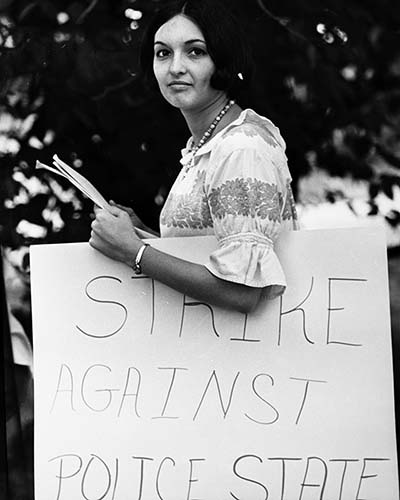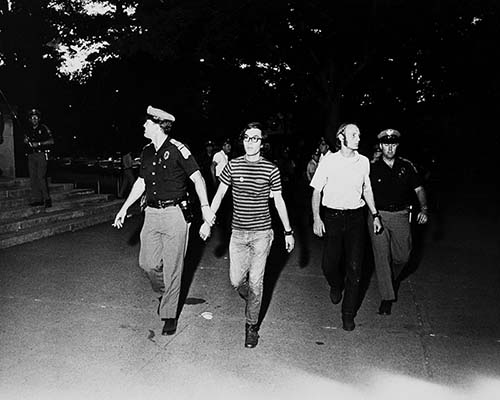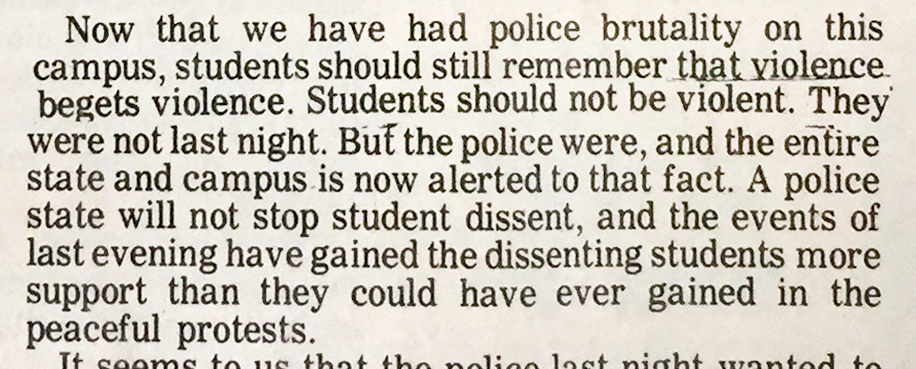Round and round and around we go
“Ball of Confusion (That’s What the World Is Today),” The Temptations
Where the world’s headed nobody knows
That the truce between Pres. Mathews and the students had been broken — and that a truce had been necessary in the first place — makes it not at all surprising that simmering tensions began to boil over.
The night of May 13-14 marks the height of the conflict between the administration and student body. It was also the period that made clear that leftist activists were far from the majority on campus.
Early afternoon
As anticipated, a “teach-in” was held at Denny Chimes on Wednesday, May 13. During this noon event, student leaders explained their demands — a sign that they were aware of needing support from more students.

Indeed, not all of those observing these activities were particularly impressed. The Tuscaloosa News spoke to a several conservative students who did not approve of the tactics of the group. For example, Ronald Sartin agreed with some of their aims but said,
“There is a right way and a wrong way to go about this and in my opinion, this is the wrong way. You haven’t got 5 per cent of the students backing you.”
Doris Flora, “Dissident Faction at UA Gets Student Opposition”
Protesters vs. President Mathews
In a bit of political theater, student protesters attempted to deliver a “subpoena” to Pres. Mathews for a trial in which they accused him of “tampering in student affairs.” This was in lieu of occupying the Alabama Union, a step student leaders could not agree to take.

The subpoena was delivered by some 150 students, who sat on the lawn of the president’s mansion for a couple of hours before returning to the Union.
Protesters vs. Anti-hippies
In the afternoon, as SFC members protested at the administration building, other students arrived with pro-Mathews signs.
But the conflict was not just about Mathews. While some students were appalled at the use of police and National Guard to quell protests, others were outraged that anyone would protest against the police.
By 8 o’clock that night, the “anti-hippy”/pro-Mathews faction had taken up a position in front of Graves Hall, across the street from the Union, so they could hold a protest of their own.

The coalition students has left the Union for a time to go see a movie in nearby Morgan Hall, but they returned to find that they had opposition. The groups were separated by University Boulevard, a matter of just a few yards.
Mathews recounted to researcher Earl Tilford that amid the rowdiness of the dual protests, someone called the Tuscaloosa police without his knowledge. While the State Troopers on campus were equipped to handle the crowd and deescalate the situation, the Tuscaloosa police apparently were not.
Head of campus police Beverly Leigh attempted to get the crowds to disperse, which somehow made the problem worse. They didn’t think they should be made to disperse, as the pro-Mathews group had not been.
According to an editorial in the Crimson White,

Protesters vs. Police
Despite or perhaps because of the mishandling of the situation by campus police, the editorial maintains that the city police presence was necessary, that, in fact, they should have been called earlier before everything flared up as it did. The way they behaved once they were on campus was the problem.
Campus police had given the crowd ten minutes to disperse, but according to the Crimson-White, city police began to move in before that period was over. Students poured out of nearby fraternity houses to see the commotion. A female student screamed out as she was arrested, which drew a crowd and brought simmering tensions to a boil.
In the chaos, law enforcement beat both protesters and bystanders with clubs. Nearly 60 students were arrested that night, and they were still being taken by bus to city jail at late as 3 a.m.

The Tuscaloosa News quotes a city official, who points out that the problem seemed to be a lack of student leadership. Student leaders like Hank Hawkins were “conspicuously absent,” contributing to the chaos.
Whatever the cause, the Crimson White editorial argues that the behavior of the police only bolstered the students’ cause:

Sources
“Ball of Confusion (That’s What the World Is Today),” performed by The Temptations and written by Norman Whitfield and Barrett Strong, was recorded in April 1970 and released the following month
Secondary
- Earl H. Tilford, “May 1970: Days of Rage and Reason,” Turning the Tide: The University of Alabama in the 1960s, Tuscaloosa: The University of Alabama Press, 2014, pgs 190-208.
Primary
- “An Editorial,” Crimson-White, May 14, 1970, pg 1.
- Doris Flora, “Dissident Faction at UA Gets Student Opposition,” Tuscaloosa News, May 14, 1970, pg 1.
- Paul Davis and Dolph Tillotson, “UA Curfew Imposed After Clash,” Tuscaloosa News, May 14, 1970, pgs 1, 2.